Personalized marketing for B2B: How to get started and improve your ROI
How much of your marketing experience is one-size-fits-all?
You already know that trying to speak to everyone in B2B or SaaS means diluting the power of your message to your actual target audiences. A personalized marketing approach, on the other hand, creates a better experience that leads to faster conversions and stronger prospect relationships.
Personalized marketing has come a long way, but it can still take up a lot of time and resources. This is especially true if you're a fast-growing company dealing with large volumes of data and different types of users. Yet personalization reaps the biggest results at scale. The more you can cut through the noise to personalize the ideal customer experience, the more successful your marketing.
So where do you start — and what makes personalized marketing worth the effort?
In this article, we'll break down what personalized marketing looks like in 2022, why companies invest in it, and how to do personalization at scale. We'll also include examples of how companies are using personalization to achieve better conversion results.
This is a long one, so buckle in and let's get started. (Already pretty convinced on the power of personalized marketing? Jump down to the touchpoint examples for some inspiration!)
Jump to:
- What is personalized marketing in 2022?
- The results of investing in personalized marketing
- How to identify audiences for segmentation
- 5 digital marketing touchpoints to personalize
What is personalized marketing in 2022?
Personalized marketing uses data to tailor messaging at scale for certain individuals or segments of buyers. Today, marketers leverage advanced technology and user data to create a tailored end-to-end journey, with targeted experiences and personalized campaigns across channels.
Personalization tech
Back in 2016, we realized at Clearbit that personalization would dominate the future of marketing. This push to be able to provide leads and buyers with tailored marketing experiences was one of the reasons we created Clearbit Reveal.
These days, marketers benefit from an abundance of personalization technology. In 2020, Statista surveyed marketers to learn how they use personalization tech, discovering that the majority of participants use email marketing (67%) and A/B testing (67%) tools for personalization. They also rely on:
- web analytics (41%)
- triggered email (38%)
- customer data platforms (30%)
- and personalization platforms (30%).
There's a lot of technology to help marketers acquire and analyze the data they need to identify and segment target audiences, and then run and test personalized marketing campaigns.
Personalization data
With improved technology comes improved ability to leverage data. Now marketers have plenty of detailed insights on who's interacting with their brand, what content they're engaging with, and where they might land within the buyer journey. With the right tools and resources, marketers can leverage this information in real time.
 Click to see larger version
Click to see larger versionDownload our guide to leveraging B2B data for personalized marketing
Personalized channels
Marketers are also expanding their personalization strategies across all of their channels. A survey of 326 marketers from Salesforce's Evergage showed that most participants use personalization for their email campaigns (78%). More than half leverage personalization on their website (56%), while only a third of marketers do so for online advertising (33%).
The marketing personalization struggle
Even with modern tech and better data, marketers struggle to bring personalized campaigns to life. The same survey found that, while marketers overwhelmingly recognize the power of personalization, actually making it happen is a challenge.
The top two obstacles to implementing personalization are resourcing issues — lack of personnel and budget.
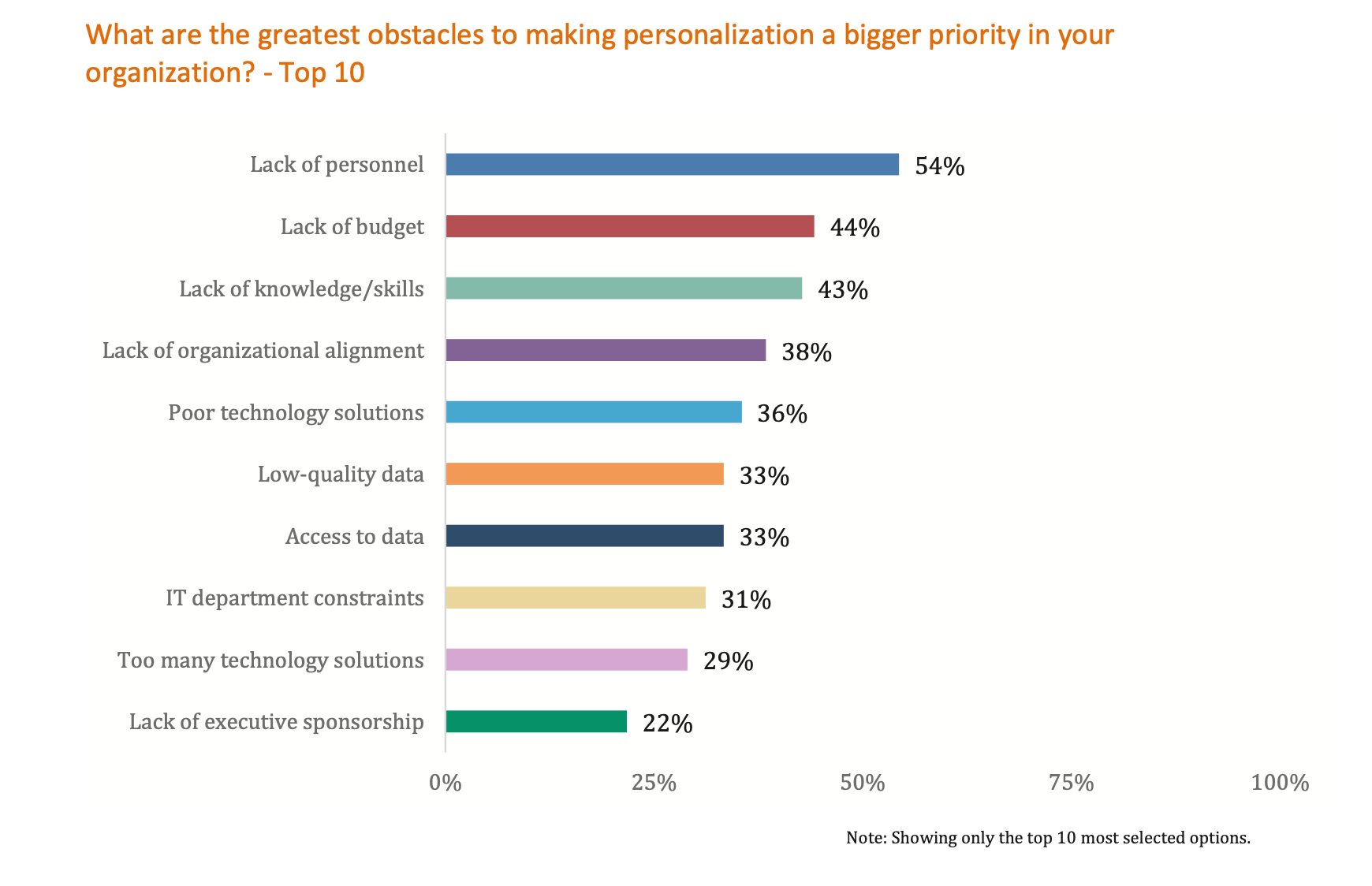 source
sourcePersonalization grows more difficult and complex, as more data, channels, and automation are thrown into the mix. Still, marketing teams continue to dedicate significant time and money to figuring out personalization for their potential customers. Gartner's research and B2B CMOs agree on why: with so much more of the customer buying journey taking place online, crafting great digital experiences for your customers is a priority in 2022.
And when it works, it pays off big.
What happens when B2B companies invest in a personalized marketing strategy?
92% of marketers say prospects expect personalized experiences. So, what happens when you deliver on those expectations? Millions more dollars in the sales pipeline, and significantly higher close and conversion rates, as Bottomline, BluLeadz, and Zenefits discovered.
1. Bottomline: $4.3 million in 18 months with personalized chat
Bottomline, a business payments solution, serves 10,000 customers with 37 products. Their website visitors were having trouble finding what they needed from the site and leaving empty-handed. So Bottomline used Drift's chatbot to guide and personalize the experience for their website visitors. The chatbot identified the visitor's intent to recommend relevant next steps and provide answers to sales questions.
The result? Bottomline generated an additional $4.3 million in sales pipeline in 18 months.
2. BluLeadz: 36.9% higher close rate with personalized videos
Marketing agency BluLeadz stepped up their game by introducing personalized videos to engage leads at different stages of the buyer's journey. With Wistia, they created video voicemails to convince new leads to hop on the phone with someone from the BluLeadz team. They also used meet-and-greet videos to improve the chances of closing late-stage deals.
By personalizing videos based on the leads' stage in the buying process, BluLeadz increased their average close rate by 36.9%.
3. Zenefits: 20% increase in conversion rate on paid social media
Zenefits wanted to increase their deal size by targeting larger companies with paid social campaigns. To go upmarket, Zenefits turned to Clearbit Advertising to better segment their Facebook advertising audiences by employee count.
Thanks to their personalized ad campaigns, Zenefits engaged a 33% larger median company size and saw a 20% increase in conversion rate for prospects moving to qualified leads.
How to identify audiences for segmentation
Before you can implement any personalized marketing, you first need to make some decisions about who to target. Personalized marketing doesn't mean tailoring to every individual or even every audience variant. Focus on just one or two of your top segments, informed by your ideal customer profile and marketing personas, and what differentiates them from the masses.
Common firmographic attributes that help differentiate these target segments include:
- industry (e.g., retail, media, tech)
- size of the company (e.g., enterprise, SMB)
- type of business (e.g., e-commerce, B2B)
- location (e.g., Northeast USA, EMEA)
You can also leverage demographic data — like job title — and behavioral data, like page views, content downloads, user journeys, and brand interactions, to further segment identified users by fit and intent.
Once you've defined your audience, double-check to see if the segment fulfills these three conditions. The audience should:
- Be identifiable: you can technically identify and act on that identity.
- Be valuable: there's value based on strategic importance, volume, or another measure, like lifetime value (LTV).
- Benefit from a specific experience: there's a noticeable advantage to creating different messaging or treatment.
How do you identify that someone fits an audience if they've never interacted with your business before? Using a reverse-IP solution like Clearbit Reveal, you can detect when a site visitor fits into your target segments — and then automatically show relevant messaging, products, and calls to action.
Within the traditional marketing funnel, someone doesn't become a lead until they hand over an email address (by filling out a form, subscribing to a newsletter, or signing up for a trial). With this Reveal method, you can recognize when specific visitors are from target accounts and provide these qualified prospects the VIP treatment.
See how Clearbit Reveal helps personalize your marketing experience.
Five digital marketing touchpoints to personalize
Let's say there's one customer segment you want to double down on because they tend to have the highest LTV. For example, you're targeting larger companies as your business moves upmarket.
Deliver a strong, compelling user experience by speaking directly to that audience's specific pain points and contexts. Do this by personalizing all interactions with that potential customer across your website, chat, email, video, and ads.
Website personalization
Your website is a key part of a lead's first impression. Based on their site experience, new visitors will decide to stay and learn more, or they'll bounce and leave without much impression at all. With personalization, you can keep them around longer and convince them to engage.
Consider this scenario. You're a marketer for a company with a CRM product, and two visitors come to your website for the first time.
- The first works at a media agency. They need in-depth customer profiling and prospecting to cycle the right customers into their business.
- The second works at a real estate company. They need to access client and broker data on their phone as they travel between showings throughout the day.
The CRM tool can fill the need for both use cases, but a generalized presentation of the product and all its many features likely won't convince either potential customer that this tool is for them.
Website personalization customizes your website content, providing a unique experience for each target audience. Showing tailored messaging, calls to action, hero images, social proof, and other elements directly speaks to the needs of your two different visitors. Sure, you've probably created specific landing pages for such segments already. But with website personalization, you can communicate these relevant value propositions on your visitors' first visits and across your entire site.
What does this look like in action? Livestorm, a webinar and video meeting platform, tripled enterprise signups and increased deal size by creating a unique homepage experience for their enterprise visitors.
They leveraged Clearbit Reveal to deanonymize their traffic and identify enterprise visitors in real-time as well as the personalization platform Mutiny to show a customized version of their messaging for enterprise visitors. See the difference below:

A great place to start experimenting with website personalization is with your headlines and CTAs. DocSend, a document-sharing software company, did this for their target audiences — startups, venture capitalists, and enterprise companies. Each audience got its own hero message, value prop statement, and social proof section with relevant company logos. The personalized social-proof section brought a 260% increase in conversions alone.
They also experimented with a modal that allowed their visitors to self-identify by selecting whether they are a founder, investor, part of a sales team, or other audience. This tactic increased DocSend's conversion to trial by 29%.
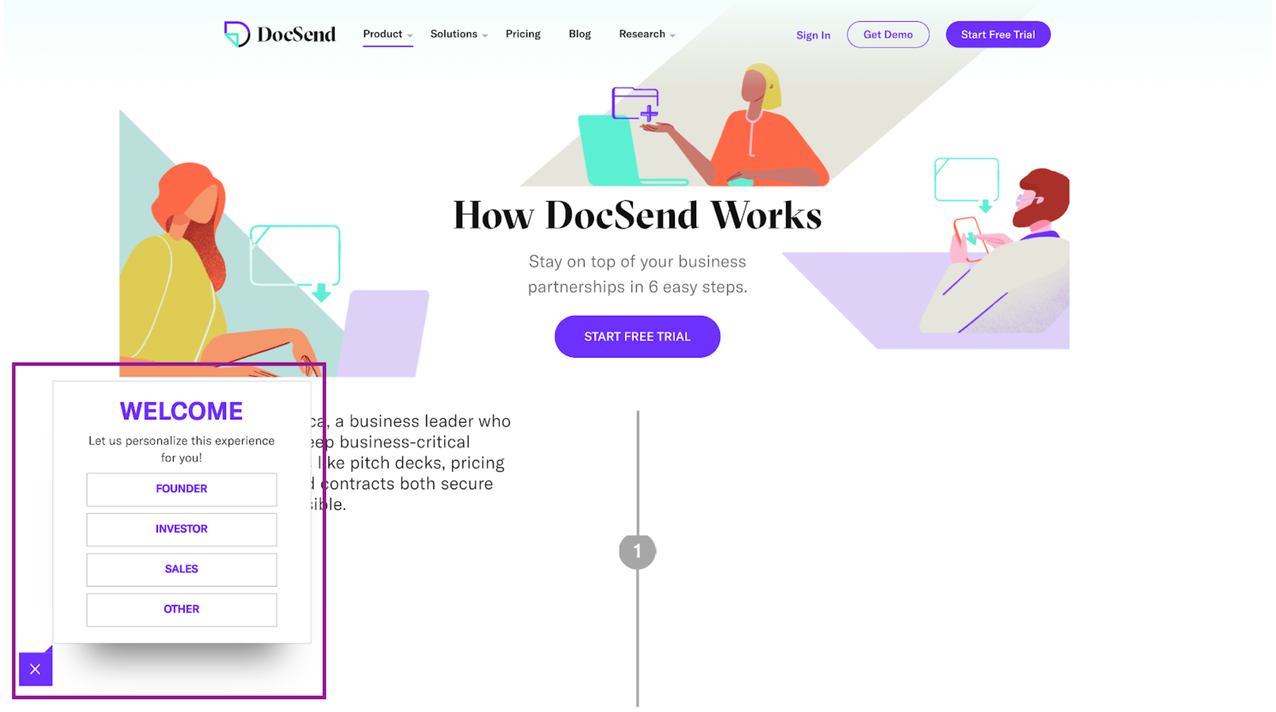 DocSend asks visitors to choose a role to personalize the experience for their core audiences.
DocSend asks visitors to choose a role to personalize the experience for their core audiences.Chat personalization
On-site chat provides a friendly way to interact with your website visitors and serve up the information they need in real time. Problem is, you often can't tell who your most high-value prospects are, out of all the people who start a chat conversation. It's a waste of time and resources to dedicate the same amount of energy to leads that don't fit your ideal customer profile (ICP).
But what if you only showed live chat to your VIPs? Then you could give them a highly personalized experience while hiding the chat feature from everyone else or giving less valuable leads a more generic treatment.
This is easy to do by integrating Clearbit Reveal with chat tools like Drift, Intercom, and Qualified to set up chat plays that trigger based on the data from Reveal. Send visitors that resemble your ICP more relevant content, like only showing a quiz, ebook CTA, or demo request flow to your qualified prospects:
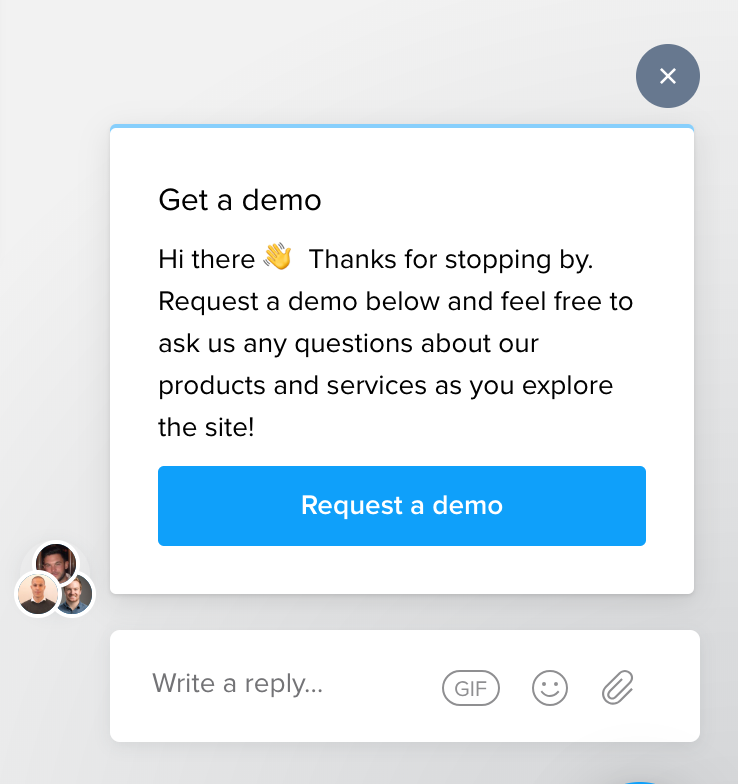 Example of proactive chat: showing demo request only to qualified prospects
Example of proactive chat: showing demo request only to qualified prospectsBetter yet, show an actual representative on the chat to provide more personalized service and signal to the visitor that they're speaking with an actual person (instead of an automated bot). You can tailor your message to use the visiting company's name and other information using your chat tool's templates and Reveal data.
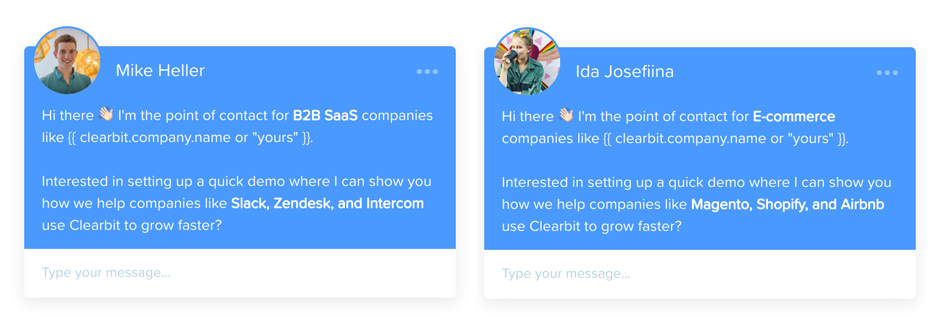 Trigger chat messages that pull in firmographic data to provide more personalized experiences
Trigger chat messages that pull in firmographic data to provide more personalized experiencesEmail personalization
Personalization can increase the return you see on your onboarding, lead, nurture, outreach, and other marketing emails.
Here at Clearbit, we've personalized emails to help move prequalified leads down the pipeline. This email campaign saw a 59% open rate and 6% conversion rate, because we sent a relevant message the moment a prospective customer showed interest (often by filling out a contact form or otherwise submitting their email on our website).
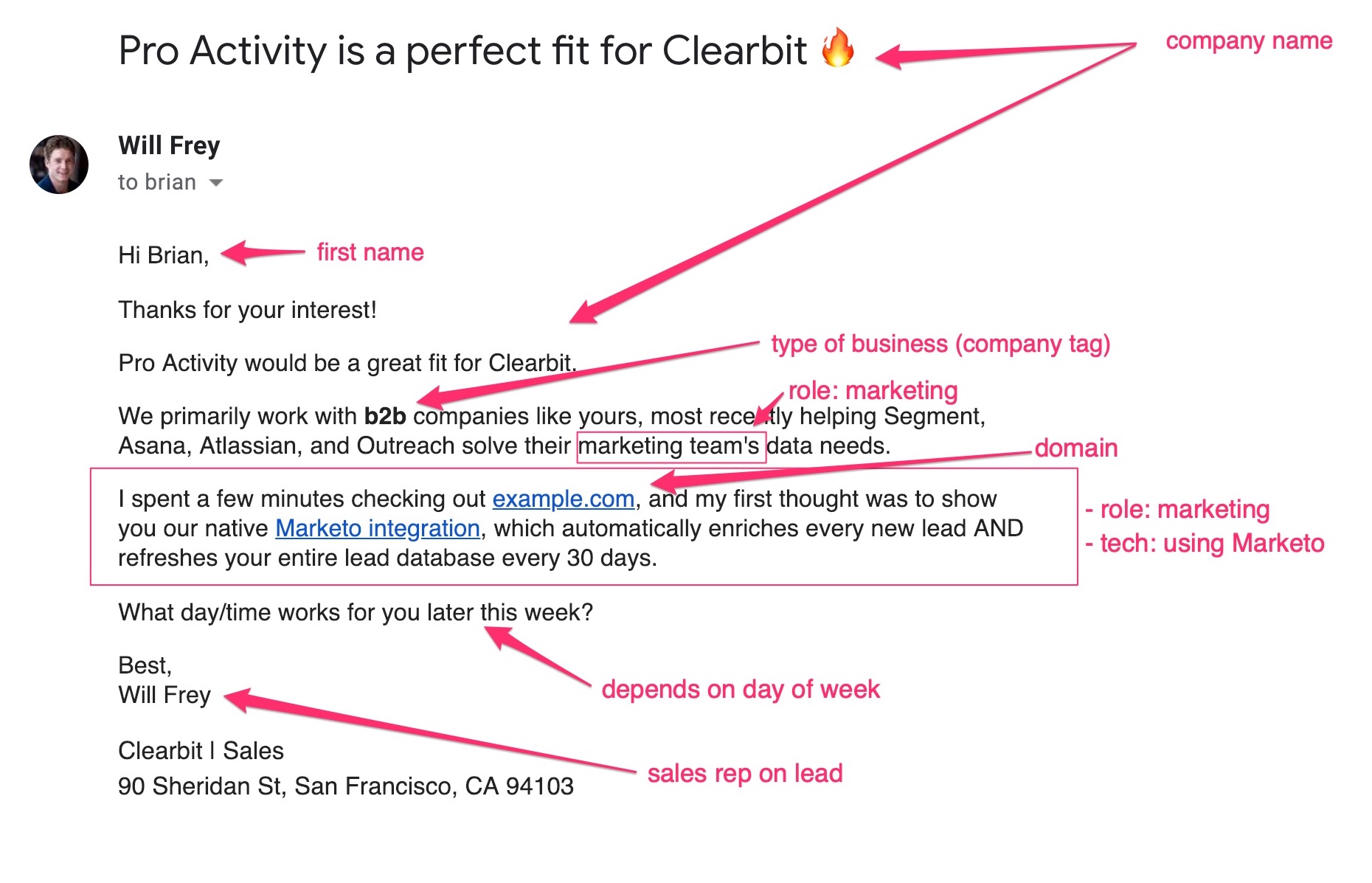 Pulling in enrichment attributes for highly customized onboarding and sales emails at scale.
Pulling in enrichment attributes for highly customized onboarding and sales emails at scale.Each of our emails looks like they're sent by a person who did some research. They welcome the customer by name and mention their company. We also tailored the subject line, messaging, and CTA based on the prospect's role, what tech they use, and other enrichment attributes. A B2B marketer who was using Marketo, for example, would get an offer of a demo to see how Clearbit's Marketo integration worked.
You can use these tactics for other types of email. Do you send out a weekly newsletter? Consider segmenting that audience further and sending personalized versions of or snippets in your newsletter instead of one-size-fits-all. You can group recipients by industry, for example, and personalize your newsletter's CTAs.
Want to learn more? Check out this deep dive on email personalization.
Video personalization
Video is an effective medium for capturing a prospect's attention and convince them to buy. In fact, according to The State of Video Marketing 2021 report by Wyzowl, “79% of people say they've been convinced to buy or download a piece of software or app by watching a video.” Push those results with video personalization.
Start by examining the video content you already use in your campaigns. Where does it live? What is its purpose? Who gets to see it? Look for opportunities to tweak those videos to better resonate with your ideal audiences and their intent.
For example, don't show everyone who visits your website the same “greetings” video at the top of your home page. Instead, create different versions of that video that talk about something different based on the visitor's industry, company size, role, or place in the funnel. This personalized approach gives you the opportunity to highlight a more effective value proposition and direct them to a more relevant CTA than a generic video.
The same goes for videos on your product pages, in your email, and even in your retargeting ads. The better you are at delivering a video that speaks directly to a specific audience's needs and takes them to the next best step, the better results you'll see.
Marketo uses personalized video in email to drive open and click-through rates. Check out this video invitation they sent out to their prospects for their 2018 Marketo Summit:

This personalized video email increased Marketo's campaign open rate by 36% and click-through rate by 144%. It features the recipient's name in scenes throughout the video, making it feel like Marketo made that video just for her. This tactic was simple to scale and boasted great results.
Ad personalization for B2B awareness and lead generation
Ads that drive traffic to your website provide one of earliest opportunities for personalization. Many B2B companies rely on LinkedIn for its business-specific targeting — but they run into cost issues and challenges with scaling after initially acquiring qualified leads there.
Advertising on Facebook (and Instagram) is appealing because of its potential reach of billions of active users. But that expansive reach comes with its own challenge — the native B2B targeting controls are Facebook is notoriously difficult and unreliable.
We've seen our customers have success reaching new qualified prospects using Clearbit Advertising, which brings LinkedIn-level targeting to Facebook. That's the ability to reach 100M+ business users in popular channels using 80+ firmographic, employee, and technographic criteria.
For example, Airbase — a business spend management software — wanted to engage new prospects and generate more qualified leads within a rather specific target audience. By using Clearbit Advertising, Airbase was able to add Facebook and Instagram as effective advertising channels, personalizing campaigns for its target market at scale — and reducing the cost per click for target accounts by half, compared to LinkedIn.
 Example of Airbase ad on Facebook
Example of Airbase ad on FacebookPersonalization starts with knowing your users
In B2B marketing, we can't rely on lowest-common-denominator or one-size-fits all experiences. Build effective and meaningful marketing personalization — from a real understanding of your customers and ability to reach and persuade the audiences that count.
By tailoring your content to better speak to each of your target audiences' needs from end-to-end, you'll drive more ideal prospects into your pipeline, win, and retain them — and continue to optimize conversion where it matters, not for the masses.
Editor's note: This post was originally published in April 2019 and updated March 2022.

